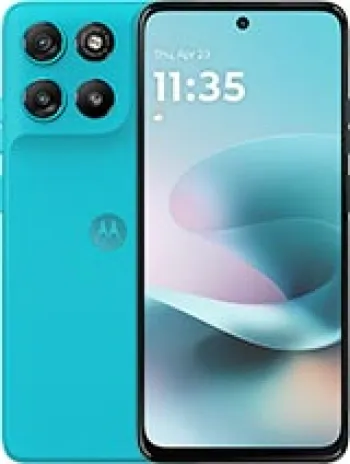
Design and Build Quality
The Motorola EM25 is characterized by a compact and lightweight design, which makes it quite portable and easy to carry around. It measures 101 x 46 x 13.9 mm and weighs only 90 grams. The phone’s construction showcases a classic candy bar design, which was a popular style during the late 2000s. Its black coloration gives it a sleek and understated look. The phone is constructed from durable materials, ensuring that it can withstand everyday wear and tear.
Display
The display on the Motorola EM25 is a 1.8-inch TFT screen, offering a resolution of 128 x 160 pixels. This results in a pixel density of approximately 114 ppi. While it might not match modern smartphone displays in terms of vibrancy and sharpness, the 65K color screen was quite sufficient for the phone's primary purposes, such as messaging and basic browsing. The screen size covers around 21.9% of the phone’s body, which is typical for phones from the era it was released.
Camera
The EM25 is equipped with a single 1.3 MP rear camera. At the time, this camera specification was adequate for basic photography needs, allowing users to capture simple snapshots. However, it lacks features such as video recording and advanced focusing capabilities. The focus of this device was not on photography, so it served more for casual photo-taking rather than professional imagery.
Memory and Storage
One of the convenient features of the Motorola EM25 is the dedicated microSD slot, which allows for expandable storage. This was a crucial feature for users who wanted to store more music, images, and other files. The phone’s internal memory is adequate for storing up to 1000 contacts, and it keeps records of the last 20 dialed, 20 received, and 20 missed calls.
Battery Life
The EM25 is powered by a removable Li-Ion 780 mAh battery, which provides up to 330 hours of standby time and about 8 hours and 10 minutes of talk time. This impressive battery life ensures that users can rely on the phone for extended periods without frequent recharging, favoring convenience and mobility, making it ideal for those constantly on the move or without regular access to charging facilities.
Connectivity and Network
The Motorola EM25 operates on GSM 900/1800 bands and supports GPRS Class 10 for data connectivity. However, it does not support EDGE technology, which means that data transfer speeds are relatively slow compared to modern standards. Bluetooth 2.0 with A2DP support is available, allowing for wireless connections to a variety of Bluetooth-enabled devices, such as headsets and speakers. The phone also includes a proprietary USB port for charging and data transfer, though it lacks WLAN capabilities, reflecting the era’s limitations.
Sound and Multimedia
The EM25’s multimedia features include a stereo FM radio with RDS, a popular choice for listening to music and catching up on radio shows. The phone supports MP3 and AAC ringtones, providing users the ability to customize their ringtone options. Additionally, the 3.5mm audio jack allows users to use their favorite headphones without the need for an adapter.
Operating System and Software
This device operates as a feature phone, meaning it does not run on advanced smartphone operating systems like Android or iOS. Instead, it includes basic apps for calling, messaging, and other functionalities. The Motorola EM25 includes SMS and MMS messaging capabilities and a WAP 2.0/xHTML browser for basic internet browsing. There are preloaded games and Java MIDP 2.0 support, allowing for additional app installations, albeit limited compared to modern smartphone platforms.
Additional Features
Despite being a feature phone, the EM25 includes several notable features. It has an easy-to-navigate interface tailored for swift access to the phone’s functionalities. While it lacks sensors that modern smartphones typically have, it effectively caters to the core needs of its users. The phone’s simplicity appeals to those looking for essential functionalities without the complexity of modern smartphones.
Availability and Discontinuation
Initially announced in August 2008, the Motorola EM25 was released to the market in July 2009. However, it has since been discontinued, with its market presence largely replaced by modern smartphones. At the time of its availability, it was priced at around 50 EUR, offering users cost-effective access to mobile communications with a range of basic yet essential features.
Conclusion
The Motorola EM25 serves as a reminder of an era when mobile phones were simple and straightforward, primarily intended for communication and basic multimedia usage. This device stood out for its reliable battery life, portability, and essential functionalities that catered to users looking for simplicity and durability in a cost-effective package. Though discontinued, the EM25 holds a place in the lineage of mobile phone development, reflecting the transition from traditional feature phones to the modern smartphone era.
Key Features of Motorola EM25
- Compact and lightweight design (90 g and 101 x 46 x 13.9 mm)
- GSM network support (900/1800)
- TFT display with 65K colors
- Expandable storage with microSD card slot
- 1.3 MP main camera
- 3.5mm audio jack available
- Bluetooth 2.0 with A2DP support
- Stereo FM radio with RDS
- Removable Li-Ion 780 mAh battery providing up to 8 hours talk time
- Affordable pricing (around 50 EUR)
Drawbacks of Motorola EM25
- Lacks EDGE support for faster data transfer.
- Discontinued model, might be hard to find support or spare parts.
- Very small screen size (1.8 inches) with low resolution (128 x 160 pixels).
- Low screen-to-body ratio (~21.9%).
- Primary camera is only 1.3 MP and lacks video recording capabilities.
- No selfie camera available.
- Does not support WLAN connectivity.
- No GPS positioning features.
- Proprietary USB connector instead of standard ones like micro USB or USB-C.
- Limited battery capacity with only 780 mAh.
- Lacks modern features like touchscreen, advanced sensors, or smart operating system.

View Also
More Phones
All Rights Reserved +14266 Phones © Mobilawy 2025

























